Toyota Motor Bundle
Who Buys Toyota Cars?
In the competitive automotive landscape, understanding customer demographics and target markets is crucial, and Toyota Motor Company exemplifies this. Toyota's success hinges on a deep understanding of its diverse global customer base. A prime example of this is Toyota's strategic shift towards hybrid and electric vehicles, catering to evolving consumer preferences.
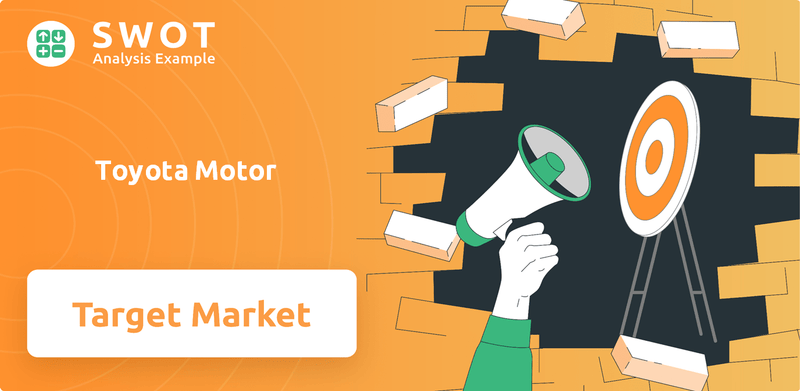
Toyota Motor Company, founded in 1937, has evolved significantly from its initial focus on Japanese automobiles. Today, Toyota Motor SWOT Analysis reveals a company that strategically adapts its offerings to meet the needs of a wide array of Toyota car buyers. This analysis delves into the specifics of Toyota customer demographics, including factors like Toyota customer age range, income levels, and lifestyle, to understand the company's market segmentation and brand loyalty factors. Understanding Toyota's target market is key to its continued success.
Who Are Toyota Motor’s Main Customers?
Understanding the Toyota customer demographics is crucial for grasping the company's market position. The Toyota target market is broad, encompassing various age groups and income levels. This diverse approach allows the company to cater to a wide range of consumers and businesses, ensuring a strong market presence.
Toyota Motor Company effectively serves both business-to-consumer (B2C) and business-to-business (B2B) segments. The B2C market includes families, younger urban drivers, and environmentally conscious consumers. The B2B segment focuses on providing commercial vehicles to businesses, further diversifying its customer base and revenue streams.
This strategy is supported by market research and external trends, allowing Toyota to adapt to changing consumer preferences and maintain its competitive edge. For a deeper dive into the company's origins and evolution, consider reading the Brief History of Toyota Motor.
Families are a significant segment, prioritizing reliable, spacious, and safe vehicles like sedans, SUVs, and minivans. Younger urban drivers, aged 18-35, seek efficiency, maneuverability, and advanced technology, often choosing compact models with hybrid options. Environmentally conscious consumers are drawn to hybrid and electric vehicles like the Prius and Camry Hybrid.
Toyota provides commercial vehicles to businesses. Sales to business customers through dealers increased by 16% in January 2025 compared to January 2024, with 3,533 units sold. This includes Light Commercial Vehicles (LCV) and Medium Commercial Vehicles (MCV). Toyota's LCV market share rose from 37.7% to 38.6%, and in the MCV segment, from 29.4% in 2024 to 38.5% in January 2025.
Toyota car buyers represent a diverse group, influenced by factors such as age, income, and lifestyle. The company’s marketing strategies are tailored to resonate with various Toyota buyer persona profiles.
- Toyota customer age range varies, with different models appealing to different age groups.
- Toyota customer income levels are broad, reflecting the range of vehicle prices and financing options available.
- Toyota customer location influences vehicle preferences based on regional needs and infrastructure.
- Toyota customer lifestyle plays a role in model selection, with options for families, urban dwellers, and outdoor enthusiasts.
Toyota Motor SWOT Analysis
- Complete SWOT Breakdown
- Fully Customizable
- Editable in Excel & Word
- Professional Formatting
- Investor-Ready Format
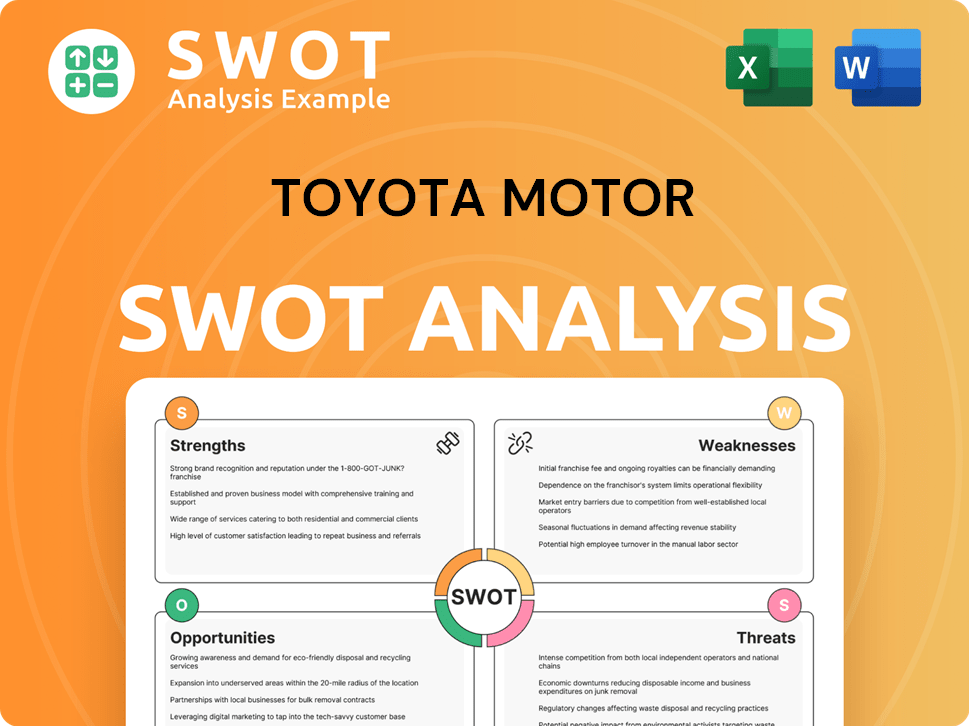
What Do Toyota Motor’s Customers Want?
Understanding the needs and preferences of its customers is crucial for the success of Toyota Motor Company. The company's approach focuses on delivering vehicles that meet the diverse needs of its customer base, emphasizing reliability, quality, safety, and innovation. This customer-centric strategy allows the company to maintain a strong market position and foster brand loyalty.
Customers of Toyota prioritize dependability and seek vehicles that offer peace of mind, viewing them as long-term investments. The company has successfully adapted to evolving preferences, particularly with the rising demand for fuel-efficient and environmentally friendly vehicles. Toyota's hybrid models, like the RAV4 Hybrid, are popular for their fuel efficiency, lower emissions, and reduced running costs.
Purchasing behaviors are also influenced by practical considerations such as fuel efficiency. Toyota has responded to this trend by making all 2025 Camry models hybrids. The company's commitment to innovation and addressing unmet needs is evident through its continuous investment in research and development, leading to the introduction of new models with cutting-edge technology and improved safety features.
Toyota's customer base is driven by key needs and preferences. These include a strong emphasis on safety, fuel efficiency, and advanced technology. The company's focus on these areas helps it meet the demands of a diverse customer base.
- Reliability and Quality: Customers consistently prioritize vehicles known for their dependability and longevity.
- Fuel Efficiency: With rising fuel costs and environmental concerns, fuel efficiency is a significant factor, driving the popularity of hybrid and electric models.
- Safety Features: Advanced safety technologies, such as Toyota Safety Sense (TSS), are crucial in purchase decisions.
- Technological Innovation: Features like cloud-based multimedia systems and smartphone integration appeal to tech-savvy consumers.
Toyota Motor PESTLE Analysis
- Covers All 6 PESTLE Categories
- No Research Needed – Save Hours of Work
- Built by Experts, Trusted by Consultants
- Instant Download, Ready to Use
- 100% Editable, Fully Customizable
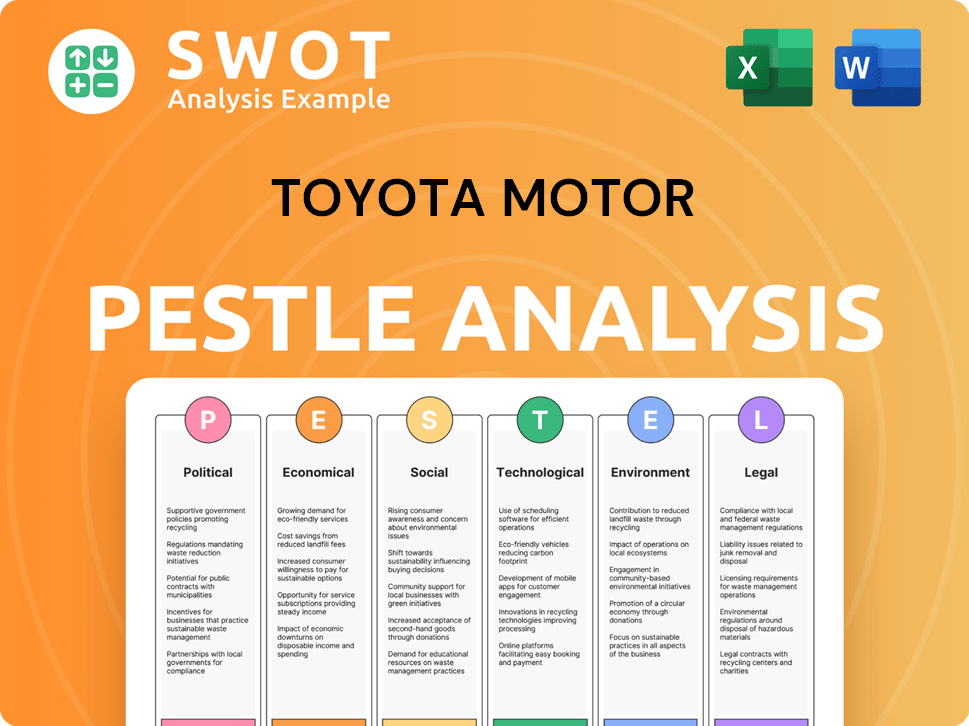
Where does Toyota Motor operate?
The geographical market presence of the [Company Name] is extensive, with a strong global footprint. The brand's success is evident in its sales figures across various regions, demonstrating its ability to cater to diverse customer preferences. In the first quarter of 2025, global sales for Toyota- and Lexus-branded vehicles increased by 4.8% to 2,515,791 units, showing its widespread appeal.
North America and Japan are key markets for the [Company Name], each with distinct consumer preferences. The company strategically adapts its offerings to meet local demands, from SUVs and trucks in North America to compact cars in urban areas. This approach allows the [Company Name] to maintain a competitive edge in a variety of markets.
The [Company Name] tailors its strategies to suit different geographical locations. For example, the demand for SUVs, trucks, and hybrids is high in North America. Conversely, in Europe and Asia, compact cars and Battery Electric Vehicles (BEVs) are more prevalent due to urban mobility trends and emission regulations. This adaptability is crucial for the [Company Name]'s global success and its ability to reach its target market.
In North America, the [Company Name] primarily targets consumers interested in SUVs, trucks, and hybrids. Sales in North America were slightly higher at 659,585 units in the first quarter of 2025. This region is a crucial market for the company.
Sales in Japan experienced a significant surge of over 37% to 557,353 units in the first quarter of 2025, recovering from production stoppages. However, fiscal year 2024 (ending March 2025) saw a 1.4% decline in Japan sales to 2,001,636 units for the group.
Toyota performed well in Europe, with a record sales result of 1.217 million vehicles in 2024, holding a 7.1% market share. Sales in Europe declined by 0.5% to 308,271 units in the first quarter of 2025. The company plans to introduce six new BEVs in Europe by 2026.
Sales in Asia (excluding Japan) rose by 3.7% to 738,862 units in the first quarter of 2025. In China, where competition with local manufacturers is intense, Toyota's sales fell by 5.9% in fiscal year 2024. This region is a key focus for future growth.
Sales in Latin America (excluding Mexico) rose by 9.5% to 116,887 units in the first quarter of 2025. This region shows strong growth potential for the [Company Name].
This includes Central and South America, Oceania, Africa, and the Middle East. The [Company Name] continues to expand its presence in these diverse markets. The company's global strategy is detailed in the Growth Strategy of Toyota Motor.
Toyota Motor Business Model Canvas
- Complete 9-Block Business Model Canvas
- Effortlessly Communicate Your Business Strategy
- Investor-Ready BMC Format
- 100% Editable and Customizable
- Clear and Structured Layout
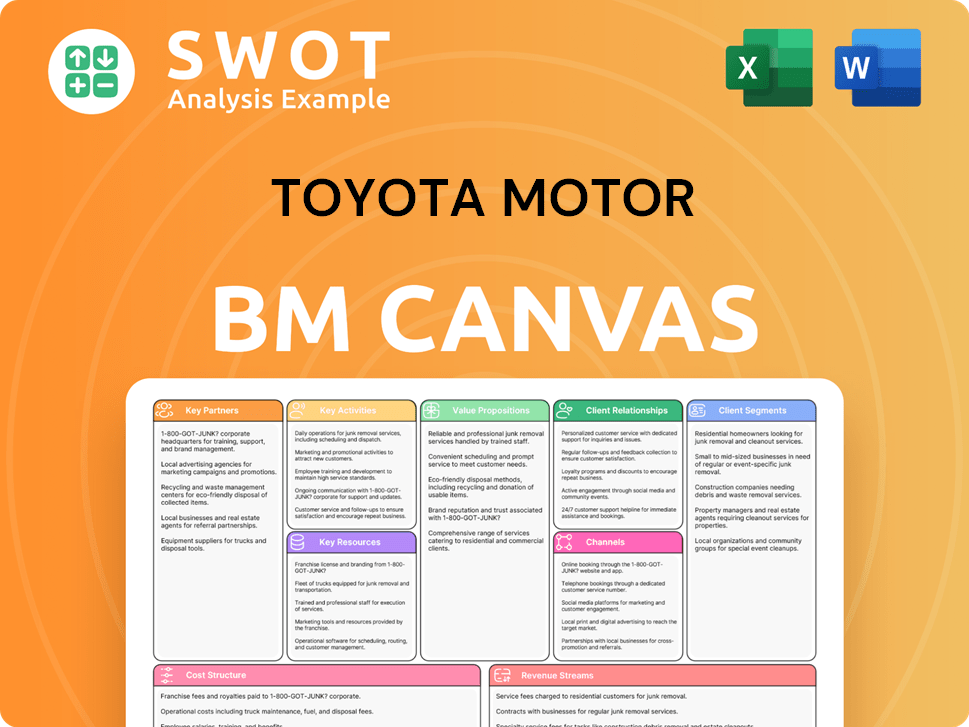
How Does Toyota Motor Win & Keep Customers?
The Toyota Motor Company employs a multifaceted approach to customer acquisition and retention, leveraging various marketing channels and customer-centric initiatives to maintain its strong market position. Understanding the Toyota customer demographics and their preferences is crucial for tailoring effective strategies. This involves a combination of digital marketing, traditional advertising, promotional campaigns, and continuous product innovation to attract and retain customers.
The company focuses on building customer loyalty through programs, personalized experiences, and strong after-sales service. This comprehensive strategy helps Toyota not only acquire new customers but also foster long-term relationships, ensuring sustained growth and market share. The strategies are constantly updated to meet the changing preferences of the Toyota target market.
By consistently emphasizing core values of reliability, durability, and innovation, Toyota has successfully positioned itself as a trusted and dependable brand, which contributes significantly to customer loyalty. The company's commitment to understanding its Toyota car buyers and their needs is evident in its strategic initiatives.
Toyota leverages digital marketing through search engine marketing, display advertising, and social media campaigns on platforms like Facebook, Instagram, YouTube, X, and LinkedIn. They engage with followers through interactive content and influencer collaborations. This helps build a community and increase brand visibility, targeting the Toyota buyer persona.
The company invests heavily in television and print advertising campaigns to create product awareness. These campaigns highlight features like reliability, quality, innovation, and environmental sustainability. This approach helps reach a broad audience and reinforce brand values, targeting different segments of the Toyota market segmentation.
Toyota frequently introduces promotional campaigns and attractive financing options to incentivize purchases. These incentives can include discounts, low-interest rates, and special lease deals. These offers are designed to attract potential buyers and make Toyota vehicles more accessible.
Toyota conducts extensive market research and segmentation analysis to identify untapped opportunities and develop targeted marketing campaigns. This helps the company understand the diverse needs and preferences of its customer base. This also helps in attracting new demographics and diversifying revenue streams.
Continuous investment in research and development for cutting-edge technology, fuel efficiency, and safety features helps attract new customers. The introduction of the all-new 2025 Camry with a standard hybrid engine is a significant product innovation aimed at attracting a wider customer base. This helps in keeping up with the evolving demands of the Toyota customer age range.
Toyota offers various loyalty programs to retain existing customers. For example, current Toyota lessees can receive discounts when leasing or purchasing a new Toyota. As of April 2024, a $1,000 Toyota Lease Loyalty Program discount was available for 2023, 2024, and 2025 vehicles when leasing, and a $500 discount for purchases. Southeast Toyota Finance offers loyalty savings of $850, including $500 Loyalty Cash and a $350 disposition fee waiver, for current lessees who finance or lease a new Toyota. These programs often target specific models like Camry, Corolla, RAV4, Highlander, Tacoma, C-HR, and Avalon.
Toyota utilizes customer data and segmentation to tailor marketing messages and experiences to individual preferences. This includes personalized offers, targeted advertising, and customized communication. This approach ensures that customers receive relevant information and feel valued.
- Tailoring marketing messages
- Personalized offers
- Targeted advertising
- Customized communication
The company emphasizes customer satisfaction through active engagement via social media, customer feedback surveys, and events, demonstrating a commitment to addressing concerns and continuously improving the customer experience. This includes providing excellent service and support to maintain customer loyalty.
- Active engagement via social media
- Customer feedback surveys
- Customer events
- Excellent service and support
By consistently emphasizing core values of reliability, durability, and innovation, Toyota has successfully positioned itself as a trusted and dependable brand, which contributes significantly to customer loyalty. This strong brand image helps in attracting and retaining customers.
- Reliability
- Durability
- Innovation
- Trusted brand
Over time, Toyota has increased its emphasis on digital outreach. The company is also focused on expanding its customer base by attracting new demographics. The goal is to increase the number of cars sold, as indicated by the message to U.S. dealers in 2025: 'build more and sell more.' This strategy aims to improve inventory and boost sales figures.
Historically, Toyota has been known for volume sales and discounts. However, a shift towards a low-inventory, high-demand strategy has been observed. This change aims to increase prices, which can contribute to higher profitability. This strategy aligns with the goal of maximizing revenue from each vehicle sold.
In 2025, Toyota is focused on improving inventory levels and increasing sales. The message to U.S. dealers, 'build more and sell more,' shows that Toyota expects to increase both inventory and sales. This is a key part of the overall growth strategy for the company. This is a direct response to the changing dynamics of the Toyota customer buying behavior.
Digital marketing has become increasingly important for Toyota. The company uses search engine marketing, display advertising, and social media to reach potential customers. This digital approach helps the company target specific demographics and increase brand awareness. This is particularly relevant to understanding the Toyota customer income levels.
Loyalty programs and personalized experiences play a key role in retaining existing customers. These initiatives are designed to reward and retain customers, fostering long-term relationships. These programs are designed to increase Toyota brand loyalty factors.
Continuous product innovation, such as the introduction of hybrid engines, attracts new customers. These innovations help the company stay competitive and meet the evolving needs of the market. This helps to understand the Toyota customer psychographics.
For more insights into the specific demographics and market strategies, you can refer to an article on the topic 0.
Toyota Motor Porter's Five Forces Analysis
- Covers All 5 Competitive Forces in Detail
- Structured for Consultants, Students, and Founders
- 100% Editable in Microsoft Word & Excel
- Instant Digital Download – Use Immediately
- Compatible with Mac & PC – Fully Unlocked
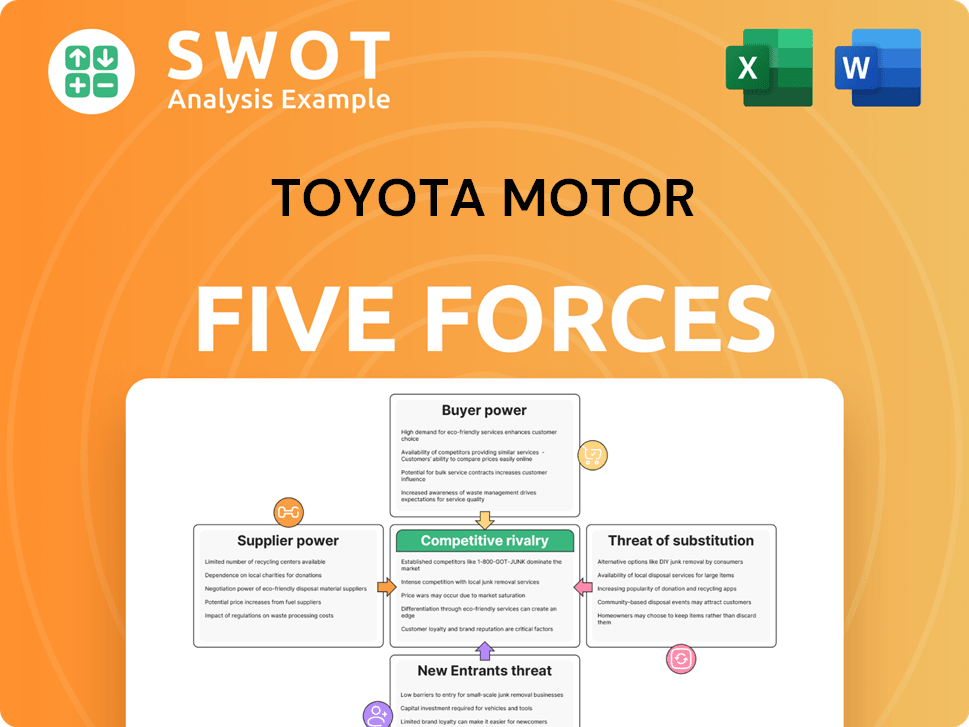
Related Blogs
- What are Mission Vision & Core Values of Toyota Motor Company?
- What is Competitive Landscape of Toyota Motor Company?
- What is Growth Strategy and Future Prospects of Toyota Motor Company?
- How Does Toyota Motor Company Work?
- What is Sales and Marketing Strategy of Toyota Motor Company?
- What is Brief History of Toyota Motor Company?
- Who Owns Toyota Motor Company?
Disclaimer
All information, articles, and product details provided on this website are for general informational and educational purposes only. We do not claim any ownership over, nor do we intend to infringe upon, any trademarks, copyrights, logos, brand names, or other intellectual property mentioned or depicted on this site. Such intellectual property remains the property of its respective owners, and any references here are made solely for identification or informational purposes, without implying any affiliation, endorsement, or partnership.
We make no representations or warranties, express or implied, regarding the accuracy, completeness, or suitability of any content or products presented. Nothing on this website should be construed as legal, tax, investment, financial, medical, or other professional advice. In addition, no part of this site—including articles or product references—constitutes a solicitation, recommendation, endorsement, advertisement, or offer to buy or sell any securities, franchises, or other financial instruments, particularly in jurisdictions where such activity would be unlawful.
All content is of a general nature and may not address the specific circumstances of any individual or entity. It is not a substitute for professional advice or services. Any actions you take based on the information provided here are strictly at your own risk. You accept full responsibility for any decisions or outcomes arising from your use of this website and agree to release us from any liability in connection with your use of, or reliance upon, the content or products found herein.